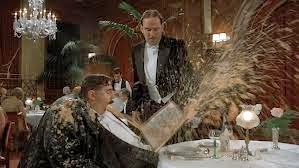From Over Your Dead Body: The History and Future of How We Deal with the Dead, Chapter XII The History of Undertaking From 1087 to now - kings, commoners, crape, jet, plumes
 |
| (photo ©jordanhoffman) |
"Georgian funerals and mourning were relatively perfunctory in terms of the time, paraphernalia and, most importantly for undertakers, money involved.
But fashion moves in cycles, and as is the way of these things, as people get bored with one thing and turn to another, what they turn to next tends towards a diametrically opposite pole of fashion in relation to the old style.
The first signs of stirrings against the rule of Classicism appeared in the Regency interest in the bizarre, the exotic and the excessive – in fashion think of Beau Brummell, in architecture, the Brighton Pavilion.
The influence of the Romantic movement in literature led a general fascination with the melancholy and soulful, and this combined with the anticlassical tendency to produce Victorian Gothic.
In parallel with this, funerals and mourning began to be celebrated more thoroughly. And there was a lot more death around to celebrate, too.
Industrialised agriculture – Jethro Tull, Turnip Townsend, Compton’s Mule, Reaper McCormick – meant that a larger population could be fed.
The mechanisation of agriculture meant less people were needed to work the land, and people moved to cities to work in the industrialised production of things the increased population wanted.
The increased population supported by industrialised agriculture had more children, and being crowded together in cities and towns with poor sanitation and rudimentary medical provision meant more death from illness, and, there being almost no health and safety legislation for the factories they worked in, there were also more deaths from accidents there.
As the industrial revolution industrialised the scale of work-related accidents, it also created more possibilities for accidents in day-to-day life, at the same time industrialising the scale of those accidents – the coming of the railways meant railway crashes, rather than horse-drawn coaches losing a wheel for instance.
Iron hulls and steam power meant bigger ships with correspondingly greater loss of life when they sank. Boilers blew up, factory and foundry fires spread to burn down swathes of overcrowded housing, sparks from ships’ steam engines set fire to the rigging which still existed on early steam vessels, the flames spread to the dockside warehouses, and huge fires regularly engulfed whole areas of port cities.
Red Sky at Night, Newspaper Proprietor’s Delight
Alongside religion, music halls, and gin palaces, one of the favourite communal diversions of the Victorian public was going to watch fires, which took hours or days to burn out and were reported as ongoing entertainment in the daily press.
This was when undertakers really came into their own. The increased interest in death combined with the increased incidence of death led to greater attention to the marking of death. Funerals became more and more elaborate and expensive, with an ever-increasing staff of attendants and more and more paraphernalia and rigmarole, all of which had to be hired from or organised by the undertaker."





